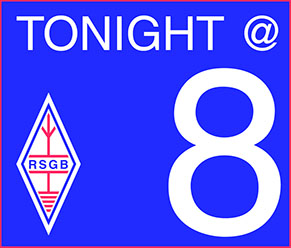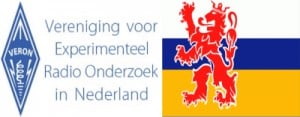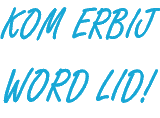Programma RF-webinar
| 12 dec 2021 | PE1RXJ | EME-QRP, zoals ontwikkeld voor JOTA-JOTI. Met technische ins en outs, detail problemen en oplossingen, testen met afstemmen op onzichtbare WebSDR signalen, waaronder oefenen met de soms extreem lastige decodering van de extreem zwakke WSJT- JT65 signalen, antenne perikelen en TRx instabiliteit. Mogelijk ook een live demo, zodat iedereen het kan zien en waar nodig zelf kan proberen, en 10 jaar praktijkervaringen bij scoutinggroepen. |
| ? gepland ? | PA0RYL | De S-meter als meetinstrument |
Oudere uitzendingen
| 10 jan 2021 | HF Techniek PA3A |
Smith diagram vanuit theorie en praktijk |
| 14 feb 2021 | Moderne zelfbouw projecten PA3FUN |
Presentatie over de Hermes Lite |
| 14 mrt 2021 | Moderne laboratorium technieken PE3ES/F4VTQ |
FT8 en WSPR met de Red Pitaya en Stem Lab, het zwitserse zakmes voor ingenieurs |
| 11 apr 2021 | PE1RXJ | Meteoren detecteren door middel van radiosignaalreflectie. Frans zal in zijn presentatie ingaan op de mogelijkheden die we zelf hebben om hiermee te experimenteren. We hebben tenslotte niet allemaal een 25m-radiotelescoop in de achtertuin staan. |
| 9 mei 2021 | PA0EHG | Drie jaar propagatiemetingen op 80 meter |
| 13 juni 2021 | Propagatie onderzoek PA2S |
Tussen schemer en dageraad |
| 11 juli 2021 | PA0SIM | HF-ontvangst vergelijken met WSPR |
| 19 sep 2021 | Antenne techniek HB9CVQ / DK2VQ |
Technische uitdagingen in HF-mobiele antennes voor 160/80 en 40m op rijdende voertuigen, met experimenten en simulaties. |
| 17 okt 2021 | Antenne techniek PA3ECT |
De lus antenne met een dominant magnetisch veld, praktisch bekeken. Aan de orde komen diverse lus antennes waarmee Hans in de afgelopen jaren goede ervaringen heeft opgedaan, zoals: – De kleine magnetic loop voor 80 meter. – De grote loop voor 80 meter. – Diverse mobiele magnetic loop antennes voor op de auto. – Delta vorm grotere loop voor veldantenne “magdelta loop” voor 80 en 160 meter. – Kleine loop antenne voor 2 meter. Veel praktische ervaringen met enige technische onderbouwing! |
| 14 nov 2021 | PA3FWM | Maxwell, de Maxwellians en de ionosfeer. De wetten van Maxwell beschrijven elektriciteit en magnetisme en vormen daarmee uiteindelijk de basis van onze hobby. Deze presentatie gaat over wat deze wetten in essentie betekenen, en hoe Maxwell en zijn volgelingen daarmee de basis legden voor de radiotechniek. Tot slot passen we deze wetten toe om te begrijpen hoe de ionosfeer onze signalen reflecteert. |
Programma RF-webinar
| 09 jan 2022 | Antennetechniek ON9CVD |
Het gebruik en de toepassing van Antennetuners, en waarom enige achtergrond kennis daarbij onontbeerlijk is! – Waarom (gebruik) – Wat (schakelingen) – Waar (toepassingsgebied) – Hoe (berekeningen) – Hoe groot (tuner rendement) – Hoe meten (enkele methoden) – Hoe verder (bronnen voor zelfstudie) |

How to get started in software construction and where it can lead you – Heather M0HMO.
All you need to get started in Software construction is a personal computer (Windows, Linux, Mac – they’ll all do), some spare time and, if you want to make a ‘thing’ then some loose change.
There are three easy and virtually free routes into writing your own programs: develop applications that run on your PC using the free Qt environment; write programs to run on one of the Arduino boards (£3 from China plus a USB cable) using the free Arduino application; or go for the middle ground with a Raspberry PI (around £40) and a wi-fi connection.
Heather will take you through the setup for each of these and show you just how easy it is to go from flashing an LED through developing an ATV receiver to producing a fully-featured windows PC application such as her Mapper entry in the RSGB construction competition.
Find out more
https://www.arduino.cc
https://www.raspberrypi.org
https://www.qt.io
https://github.com/
=========================
As part of the national “Get on the air to care” campaign with the NHS, the RSGB Tonight @ 8 series of live webinars cover a range of topics and help you gain more enjoyment from amateur radio.
Tonight @ 8 webinars are live-streamed, allowing you to watch the presentations and ask questions online. They can also be viewed on a later date on the RSGB website and YouTube.
Info : https://rsgb.org/main/tonight-at-eight-live-webinars/
Deze avond zal Ernst PA1EJO een online lezing verzorgen over “Storingen veroorzaakt door PV installaties (zonnepanelen).
Dit beloofd weer een interessante avond te worden.
=======================================================
Zoals voorgaande lezingen zal ook deze weer gehouden worden via Jitsi, met als adres : meet.jit.si/pi3zlb
Ga op de avond van de lezing in een moderne webbrowser naar de url.
NB dit is dezelfde url die ook voor de streaming van de zondagochtendronde wordt gebruikt.
Om 20.00 uur willen we met de lezing starten, maar voor wat laatste checks m.b.t. de ICT instellingen is het virtuele zaaltje al eerder toegankelijk.
Programma RF-webinar
| 23 jan 2022 | Actualiteit PA0HKZ + PA0EHG |
Open discussie over de invloeden van de Tonga vulkaanexplosie op de HF banden.
De barometergrafiek die Henk PA0HKZ hier in JO22PC op 20 januari registreerde, toont duidelijk de short-path drukgolf van de Tonga vulkaanuitbarsting rond 21:00 uur. Ook de long-path drukgolf is zichtbaar. |
| 13 feb 2022 | Meettechniek PE1FOD |
Ruisfactor meten met een Spectrum Analyzer |
| 13 mrt 2022 | PA1EJO | EMC problematiek en oplossingen voor PV installaties |
| 10 apr 2022 | PA3A | Smith Chart “Booster” |
Eerder gegeven webinars dit jaar
| 9 jan 2022 | Antennetechniek ON9CVD |
Het gebruik en de toepassing van Antennetuners, en waarom enige achtergrond kennis daarbij onontbeerlijk is! – Waarom (gebruik) – Wat (schakelingen) – Waar (toepassingsgebied) – Hoe (berekeningen) – Hoe groot (tuner rendement) – Hoe meten (enkele methoden) – Hoe verder (bronnen voor zelfstudie) |
FOSDEM is a two-day event organised by volunteers to promote the widespread use of free and open source software.
Usually taking place in the beautiful city of Brussels (Belgium), FOSDEM is widely recognised as the best such conference in Europe.
What is FOSDEM?
FOSDEM is a free and non-commercial event organised by the community for the community. The goal is to provide free and open source software developers and communities a place to meet to:
- get in touch with other developers and projects;
- be informed about the latest developments in the free software world;
- be informed about the latest developments in the open source world;
- attend interesting talks and presentations on various topics by project leaders and committers;
- to promote the development and benefits of free software and open source solutions.
Participation and attendance is totally free, though the organisers gratefully accept donations and sponsorship.
Developer rooms
The FOSDEM team feels it is very important for free and open source software developers around the world to be able to meet in “real life”.
To this end, we have set up developer rooms (devrooms) with network/internet connectivity and projectors where teams can meet and showcase their projects. Devrooms are a place for teams to discuss, hack and publicly present latest directions, lightning talks, news and discussions. We believe developers can benefit a lot from these meetings.
——————————————-
Free Software Radio Devroom : https://fosdem.org/2022/schedule/track/free_software_radio/
FOSDEM is a two-day event organised by volunteers to promote the widespread use of free and open source software.
Usually taking place in the beautiful city of Brussels (Belgium), FOSDEM is widely recognised as the best such conference in Europe.
What is FOSDEM?
FOSDEM is a free and non-commercial event organised by the community for the community. The goal is to provide free and open source software developers and communities a place to meet to:
- get in touch with other developers and projects;
- be informed about the latest developments in the free software world;
- be informed about the latest developments in the open source world;
- attend interesting talks and presentations on various topics by project leaders and committers;
- to promote the development and benefits of free software and open source solutions.
Participation and attendance is totally free, though the organisers gratefully accept donations and sponsorship.
Developer rooms
The FOSDEM team feels it is very important for free and open source software developers around the world to be able to meet in “real life”.
To this end, we have set up developer rooms (devrooms) with network/internet connectivity and projectors where teams can meet and showcase their projects. Devrooms are a place for teams to discuss, hack and publicly present latest directions, lightning talks, news and discussions. We believe developers can benefit a lot from these meetings.
——————————————-
Free Software Radio Devroom : https://fosdem.org/2022/schedule/track/free_software_radio/

The Russian Woodpecker over the horizon radar, a blast from the past – Keith KI6BDR.
Hidden deep in a serene forest yet taller than the clouds, standing in surreal beauty is an antenna array like none other on earth, having an aperture area greater than 15 U.S. football fields. One of the great wonders of the world – a top secret Soviet radar, so secret that even the name is uncertain, for it had many. It was the Russian Woodpecker. It was the Steel Yard. It was Duga.
The story of this top secret place is one of mystery and intrigue. Now abandoned, a rusting testament to man’s cold war hubris, almost all popular accounts on the web are seriously flawed – victims of deliberate disinformation. Where did it come from? What did it do? Did it transmit? Did it receive? Was it the first of three, or the third of two?
Keith Snyder, KI6BDR, has been busy reverse engineering to uncover truth before time erases history. Keith shows visible engineering clues that reveal the mission and correct the history of the huge “Duga 3” antenna Array. The Duga 3 is located a few kilometers from the Chernobyl nuclear power plant site. Although it has fallen into disrepair, it stands today due only to a hasty exit forced by radiation from the
Chernobyl nuclear accident. The nuclear accident ironically protected the array from dismantlement, a reprieve from all but the ravages of time. The antenna array today attracts tourists who visit Chernobyl. It is one of the 8th wonders of the world due to its Titanic size.
=========================
As part of the national “Get on the air to care” campaign with the NHS, the RSGB Tonight @ 8 series of live webinars cover a range of topics and help you gain more enjoyment from amateur radio.
Tonight @ 8 webinars are live-streamed, allowing you to watch the presentations and ask questions online. They can also be viewed on a later date on the RSGB website and YouTube.
Info : https://rsgb.org/main/tonight-at-eight-live-webinars/
Deze avond zal zal Jeroen PE1RXQ een lezing verzorgen over Digital Voice.
De tijd dat zendamateurs voor spraakverbindingen alleen konden kiezen uit FM, SSB of AM ligt achter ons. Tegenwoordig zijn er ook volledig digitale modulatie technieken voor spraak. Sommige daarvan m.b.v. een gesloten protocol of commerciële hardware, andere volledig open source zoals FreeDigitalVoice.
Jeroen is ook voorzitter van de VERON afdeling Eindhoven en heeft naast FreeDV ook met DMR en APRS geëxperimenteerd.
Dit beloofd weer een interessante avond te worden.
=======================================================
Zoals voorgaande lezingen zal ook deze weer gehouden worden via Jitsi, met als adres : meet.jit.si/pi3zlb
Ga op de avond van de lezing in een moderne webbrowser naar de url.
NB dit is dezelfde url die ook voor de streaming van de zondagochtendronde wordt gebruikt.
Om 20.00 uur willen we met de lezing starten, maar voor wat laatste checks m.b.t. de ICT instellingen is het virtuele zaaltje al eerder toegankelijk.

Die für den 12. Februar 2022 geplante GHz-Tagung Dorsten muss leider ausfallen.
Zum zweiten Mal in Folge treffen sich die Mikrowellenamateure nicht im Februar in Dorsten, um sich über die neuesten Entwicklungen auf den GHz-Bändern und das vergangene Contestjahr auszutauschen. Die aktuelle Entwicklung der Pandemielage lässt eine Durchführung der Tagung leider nicht zu.
Auf unsere Webseite wird ab Spätsommer 2022 die Ankündigung für die GHz-Tagung 2023 veröffentlicht, die dann hoffentlich wieder in altbewährter Form stattfinden soll. Die Tagungsleitung freut sich bereits jetzt schon darauf, die Mikrowellenamateure 2023 endlich wieder in Dorsten begrüßen zu dürfen.
=========================================
Die GHz-Tagung in Dorsten beschäftigt sich mit dem Amateurfunkbetrieb auf Frequenzen oberhalb von 1,2 GHz.
Die GHz-Tagung lebt von den zahlreichen Fachvorträgen und der Möglichkeit des persönlichen Gesprächs. Sie wird jedes Jahr von mehr als 200 Funkamateuren besucht, um über die neuesten Entwicklungen auf den GHz-Bändern zu diskutieren. Zudem wird hier jedes Jahr der DARC-UKW-Contestpokal verliehen.
Die Tagung wird organisiert vom DARC-Distrikt Westfalen-Nord. Unterstützt wird die GHz-Tagung durch die Volkshochschule Dorsten.



